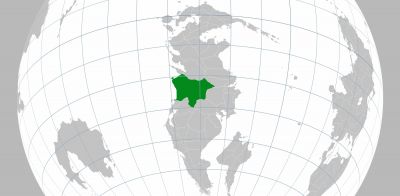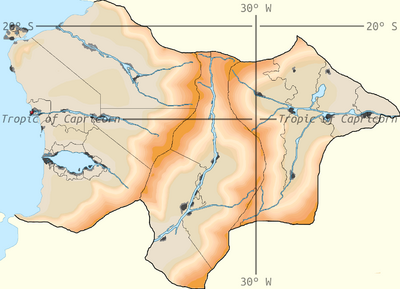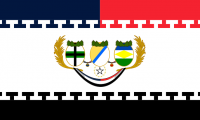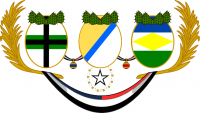UPRAN (Pacifica)
United Provinces of Rhayna, Alla-gy and Néa-gy Ηνωμένες Επαρχίες του Ράινα, Αλλα-Γη και Νέα-Γη | |
|---|---|
Motto: Long Life Us All Mάκρος ζωή Μας Ολοι | |
Anthem: Path for All Μονοπάτι για Óλους | |
 Location of Rhayna in the South Pacific | |
 Closeup of Rhayna | |
| Capital | Pzárya |
| Largest city | Rouketá |
| Official languages | Aegean, Austral |
| Recognised national languages | Aegean, Austral |
| Sign languages | Aegean Sign Language Νοηματική Γλώσσα Αιγαίο (ΝΓA/NGA) Austral Sign Language (ASL) |
| Religion (2020 census) | 51.0% Religious 47.1% No religion 1.9% Unanswered |
| Demonym(s) | Rhaynan |
| Government | Federal democratic parliamentary constitutional republic |
• Prytanis | Boutros Georgiou |
| Gisella de Luca | |
| Aria Iliadis | |
| Fabiano Marchesi | |
| Astra Panou | |
| Legislature | Genikés Kámeres |
| UPRAN Congress | |
| Rhayna's Chamber of Deputies | |
| Federal independent republic | |
• Ancient Rhayna | 3145-520 BC |
• Ancient Erimos | 520-327 BC |
• Ancient Vregménos | 327-25 BC |
• Italikís Conquest | 25 BC-646 AD |
• Deodian Dictatorship | 646-709 AD |
• Rhayna's 1st Great Republic | 709-843 |
• Rhaynan Kingdom | 843-1085 |
• Rhayna's Great Division | 1078 |
• The Union Revolution | 1085 |
• Rhayna's 2nd Great Republic | 1085-1512 |
• Great Rhaynan Kingdom | 1512-1922 |
• Rhayna's 3rd Great Republic | 30 September, 1923-1953 |
• Eliánic Dictatorship | 7 July, 1953-1965 |
• UPRAN Republic | 6 May, 1965-2021 |
| Area | |
• Total | 931,948 km2 (359,827 sq mi) |
| Population | |
• 2021 estimate | 57,825,790 |
• 2020 census | 51,173,265 |
• Density | 54.95/km2 (142.3/sq mi) |
| GDP (PPP) | 2020 estimate |
• Total | 2.37 trillion |
• Per capita | $46,313.25 |
| GDP (nominal) | 2020 estimate |
• Total | 1.77 trillion |
• Per capita | $34,564.30 |
| Currency | Sigma (SIG) |
| Time zone | UTC-3, -2 (CCT) |
• Summer (DST) | UTC-2, -1 (CCT) |
| Date format | dd/mm/yyyy CE |
| Driving side | right |
| Calling code | +65 |
| World Forum Code | RHA |
| Internet TLD | .rha, .ραι |
Rhayna (Aegean: Ράινα, Aegean pronunciation: [ráina]), United Provinces of Rhayna (Aegean: Ηνωμένες Επαρχίες του Ράινα, Aegean pronunciation: [inoménes eparchíes tou ráina]) or United Provinces of Rhayna, Alla-gy and Néa-gy (Aegean: Ηνωμένες Επαρχίες του Ράινα, Αλλα-Γη και Νέα-Γη, Aegean pronunciation: [inoménes eparchíes tou ráina alla gi kai néa gi]) is a big sized country located in the South Pacific and located in the middle of Cordilia, bordered by Qaweritoyu and Nori Natto to the north; the Míkos Plain at the east; the Valkyrian Republic, Hystaiga and the Federal Union of Kosbareland to the south; and the Cordilian Sea to the west.
Composed of three main parts, Rhayna's territory splits into three regions; Rhayna, Alla-gy and Néa-gy, which, in order, enter the interior of the continent from the east. It covers an area of 931,948 square kilometers (359,827 sq mi) and it has mainly an arid climate, except to the east in Neá-gy, where it has a humid subtropical climate, and on the banks of large rivers such as the Trómeros or Apóala, where it is usually cultivated after its annual floods. Its is Pzárya, located in Rhayna at the mouth of the Imísy, and the largest city is Rouketá, with Pzárya just behind.
Rhayna was the cradle for the ancient civilization that was born on the shores of Trómeros and its lake Kryó, which between 520 BC and 25 AD expanded to the territory behind the mountain ranges of Prostasía and Défteros. During the conquest, natives from the north of Néa-gy attacked back, which led to the Deodian dictatorship in 646 BC in order to unify the three territories and maintain control in Néa-gy.
At the beginning of the 8th century the Deodian dictatorship ended and Rhayna's 1st Great Republic was created. This did not last long, and after a century it was replaced by a monarchy started in Rhayna. This triggered the creation of independent kingdoms in Alla-gy and Néa-gy, which caused Rhayna's Great Division and dissolution of the great territory. In 1085, the Union Revolution broke out, leading to the execution of the kings of Rhayna, Alla-gy and Néa-gy, the union of the three territories and the creation of Rhayna's 2nd Great Republic, which lasted until the early 16th century, more than 400 years.
In 1512 the expansion of the Union was necessary, so the Great Rhaynan Kingdom was established, whose function was to direct population campaigns in the deserts of Rhayna and Alla-gy, through the establishment of irrigation and villages in the vicinity of Prostasía and Défteros. This ended in warlike tensions with Hystaiga in the Apóla War, which resulted in Rhayna's 3rd Great Republic and the almost total population of the Rhayna and Alla-gy deserts in the early 20th century.
Thanks to the creation of the railroad, full communication was achieved between the previously almost totally isolated regions of Rhayna, which allowed a greater stability of the Union and avoid an event like that of Rhayna's Great Division. In the middle of the 20th century, a coup against the government of the 3rd Republic was committed by Elián Vasileiou, and a personalist dictatorship was established. This dictatorship only lasted 12 years, thanks to the troops of Rhayna and Néa-gy, Elián was captured and executed for crimes of mass genocide and war crimes against the minority populations of Alla-gy. In 1965 the UPRAN Republic was established, the Union's Constitution was written and stability has been maintained to this day.
On the world stage, Kosbareland was involved in the Great War on the winning allied side.
Today Rhayna is an independent democratic constitutional republic led by the prytanis and viceprytanis. It is a developed nation that offers various welfare services. Among its raw materials are hydroelectric and solar energy, oil, metals and beef, in addition to offering tourism services such as long cruise trips on the Trómeros or the Imísy or visits to museums with various relics of Ancient Rhayna. The different regions of Rhayna have partial autonomy in their decisions except in the army and vital services, which are controlled by the central government.
Etymology
Rhayna's name has been distorted over the years, although in Aegean it can still be translated as "rain", which is strange considering the main climate. Theories hold that civilization grew on the shores of lake Kryó, which would release large amounts of moisture into the air that would fall as rain, which would explain in a certain part the ironic name.
History
- Main article: History of Rhayna
Fossils found in the Trómeros delta date from between 130,000 and 280,000 years ago, while in other rivers it is somewhat more recent, and the first constructions date from 5,000 years ago, which shows that there were human settlements for a long time, since before writing.
Ancient Rhayna
The great fertility of the sediments left in the annual floods of Trómeros, together with the isolation of towns thanks to the Rhaynan Desert, allowed the development of the rhaynan civilization.
The first settlers of Rhayna reached the shores of Lake Kryó and expanded west to the Trómeros delta, at that time a cluster of marshes and a focus of diseases, escaping the desertification of central Cordilia. The first towns, by means of irrigation systems, made the area habitable, and grouped the riverbed areas and cultivable areas in Tmímats.

